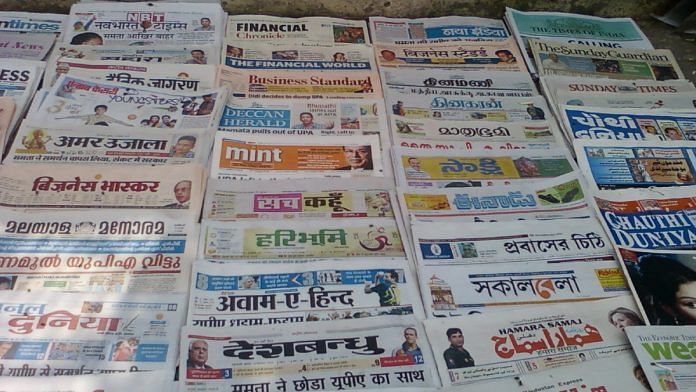New Delhi: Politicians from major parties in India tend to show preferences for certain publications when engaging with journalistic content on Twitter, according to a study of retweets released online Monday by researchers from the University of Michigan in the US.
And unlike the handles of media houses — which tend to be more evenly divided between the ruling Bharatiya Janata Party (BJP) and the opposition — individual journalists overall tend to be engaged much more significantly by the opposition, the report says.
Titled ‘Indian Journalists on Twitter and their Politician Footprint’, it talks about how “the positions of journalists on issues can be understood vis-a-vis institutions they report on”.
Discussing media houses, it says, “Three media groups fall solidly on the BJP side in terms of engagements by politicians — the Zee Group, the Republic group and the Jagran Group. On the opposition side, NDTV’s Hindi and English offerings both tend to be engaged mainly by the opposition (@ndtvindia by Samajwadi Party and @ndtv by INC), while the India Today group also generally falls on the opposition side.”
The Times Group, on the other hand, has channels and newspapers placed at several different points along the spectrum of “polarisation”, according to the study.
International media houses in India are increasingly engaged by opposition leaders except for CNN-News18, which “tends to lean heavily towards the BJP, whereas its content partner @CNN, in general, tends to lean liberal in the US”.
For the study, the authors accessed a database of approximately 40,000 Indian politicians and 4,099 Indian journalists. They “examined every retweet (excluding quoted tweets) contained within the last 1,000 messages (or less, if the politician tweeted less frequently) from politicians’ accounts”.
This was done for almost a year, from 1 August 2021 to 14 September 2022, to “map out partisanship” and understand “whose journalism is broadcast by which party”.
Also Read: Markandey Katju back on social media, with hot takes and tales of encounter with ‘young ladies’
Few journalists with equal favour
In terms of individuals, opposition leaders tend to engage more with beat reporters or political editors with traditional newspapers, as well as independent journalists who take part in “traditional on-the-ground reporting rather than anchoring”, the report says.
The BJP, however, has built a stronger network with “star influencers” and “high-followed anchor accounts” that have more than a million followers.
“@RajatSharmaLive, @RubikaLiyaquat, @DChaurasia2312 and @SushantBSinha each were retweeted over 150 times by BJP leaders in the study period alone. In contrast, only two journalists with a mega-following of 1 million plus — @ppbajpai and @ajitanjum — get more than 100 engagements from one or another major opposition party,” adds the report.
The BJP has also engaged heavily with public commentators who may not have a journalistic background.
On the other hand, there are journalists such as Rajdeep Sardesai, Rana Ayyub, Abhisar Sharma and Suhasini Haidar, who weren’t retweeted even once by politicians from the BJP in the period of the study.
The report adds that there are a small number of “crossover” journalists — those who are retweeted by parties from across the spectrum. The most significant is L.P. Pant, the editor of Dainik Bhaskar, according to the study.
And which party engages the most with journalistic content? According to the report, it’s the Aam Aadmi Party (AAP), both in terms of the “number of journalists” and the “number of media handles retweeted per politician”. The authors credit the “media firepower” of AAP’s outreach system to journalists who’ve joined the party.
The report also narrows down some significant key words that led politicians to retweet or engage with journalists. Words like “minister, shri, birthday, spokesperson, senior, press and conference” in a tweet made politicians engage more. Similarly, themes like “breaking news, policy matters, elections and schemes” were popular.
(Edited by Theres Sudeep)
Also Read: Facing boycott calls? Show a little courage and wait for the mob to give up and move on



